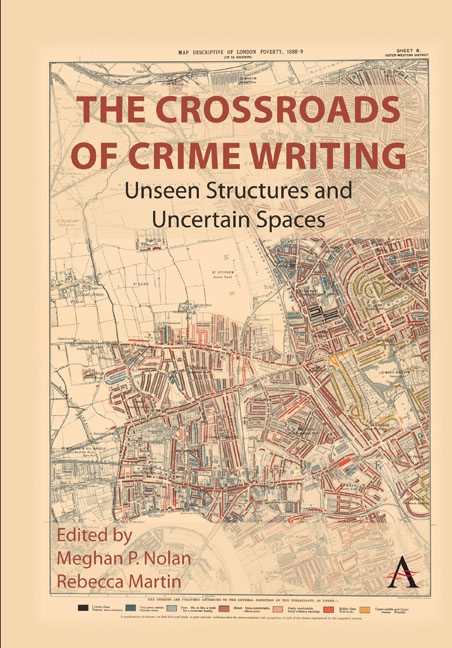Book contents
- Frontmatter
- Contents
- Introduction
- Unseen Structures
- Chapter 1 Unseen Structures and the Outlaw: Depictions of Violations in Stieg Larsson’s Millennium Trilogy
- Chapter 2 Dark Waters: Eco-Noir in New York 2140
- Chapter 3 Between Lenin and Sherlock Holmes: Soviet Militsiya Procedural in Volodymyr Kashin’s Detective Fiction
- Chapter 4 Detecting Justice: Black Crime Fiction and the Novels of Attica Locke
- Chapter 5 The Police and the Private Eye: The Making of Gendered and Racial Peripheralization in the Crime Fiction of Valerie Wilson Wesley
- Uncertain Spaces
- Chapter 6 Navigating the Carceral City: Calcutta in Late Nineteenth-Century Narratives of Detection
- Chapter 7 Traversing the Borders of Poverty and Morality: The Intersection of Maps and Upper-Class Ethics in Anne Perry’s Neo-Victorian Series
- Chapter 8 Facts and Fictions: The Liminal Space Between True Crime and Crime Fiction
- Chapter 9 The Success(Ion) and Corruption of Crime Genres in Jo Nesbø’s Macbeth (2018)
- Chapter 10 The Golden Age Meets the Age of Aquarius: Agatha Christie in the 1960s
- Notes on Editors and Contributors
- Permissions
- Index
Chapter 1 - Unseen Structures and the Outlaw: Depictions of Violations in Stieg Larsson’s Millennium Trilogy
Published online by Cambridge University Press: 13 April 2024
- Frontmatter
- Contents
- Introduction
- Unseen Structures
- Chapter 1 Unseen Structures and the Outlaw: Depictions of Violations in Stieg Larsson’s Millennium Trilogy
- Chapter 2 Dark Waters: Eco-Noir in New York 2140
- Chapter 3 Between Lenin and Sherlock Holmes: Soviet Militsiya Procedural in Volodymyr Kashin’s Detective Fiction
- Chapter 4 Detecting Justice: Black Crime Fiction and the Novels of Attica Locke
- Chapter 5 The Police and the Private Eye: The Making of Gendered and Racial Peripheralization in the Crime Fiction of Valerie Wilson Wesley
- Uncertain Spaces
- Chapter 6 Navigating the Carceral City: Calcutta in Late Nineteenth-Century Narratives of Detection
- Chapter 7 Traversing the Borders of Poverty and Morality: The Intersection of Maps and Upper-Class Ethics in Anne Perry’s Neo-Victorian Series
- Chapter 8 Facts and Fictions: The Liminal Space Between True Crime and Crime Fiction
- Chapter 9 The Success(Ion) and Corruption of Crime Genres in Jo Nesbø’s Macbeth (2018)
- Chapter 10 The Golden Age Meets the Age of Aquarius: Agatha Christie in the 1960s
- Notes on Editors and Contributors
- Permissions
- Index
Summary
Introduction
As a globally shared world literature, the crime fiction genre, following Beecroft's model, constitutes an ecology of co-existing works that connect national literatures to a global world literature system. The genre sprawls over time periods and spills over its generic borders to connect to other ecologies, depending on how crime fiction is defined. Sophocles's Oedipus Rex, for example, can be seen as crime fiction, as can the oral folklore tales of the world about life, death, justice systems and punishment, or religious and mythological writings encompassing crimes. The multifaceted crime fiction genre is well-known for representing its own sociopolitical context and posing social critique through its narratives. Often it serves as a gateway within scholarly research to topics such as ethnicity, gender, or class, and in relation to the nation-state, views on crimes, and injustice. As a whole, crime fiction is a globally circulated national literature, born out of modernity, with roots in urbanization and technological changes. At the turn of the twenty-first century, the genre evolved into a highly successful entertainment industry on the international book market, governed by multimedia conglomerates. The literature's geographical belongings often serve as a marketing strategy and tool for organizing foreign novels, for example, as Swedish Crime Fiction, Scandinavian Crime Fiction, or Nordic Noir.
In crime fiction, place holds a key position as it connects the narratives to claims of national belonging. Place gives crime stories a scenic framing and, in doing so, these stories become ambassadors for their countries of origin or particular cities like Beijing, Cairo, London, Los Angeles, or Milan. Crime narratives must be located somewhere in a particular city, jurisdiction, state, or country. These geographical places function as backdrops for the story, even when the local settings in the narratives stretch out far beyond national borders and into the global. Thus, recent crime fiction studies argue for readings that look beyond the novels’ national traditions, to focus instead on ideas about global injustice that transgress national borders. As such, the classic “scene of the crime” in these narratives becomes a means to examine how a crime in a very particular local milieu intersects with, and has implications for, a wider set of global issues and efforts to police crime at a global rather than at a merely national or local level.
- Type
- Chapter
- Information
- The Crossroads of Crime WritingUnseen Structures and Uncertain Spaces, pp. 21 - 40Publisher: Anthem PressPrint publication year: 2024



